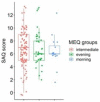Sleeping with time in mind? A literature review and a proposal for a screening questionnaire on self-awakening
- PMID: 36952462
- PMCID: PMC10035927
- DOI: 10.1371/journal.pone.0283221
Sleeping with time in mind? A literature review and a proposal for a screening questionnaire on self-awakening
Abstract
Some people report being able to spontaneously "time" the end of their sleep. This ability to self-awaken challenges the idea of sleep as a passive cognitive state. Yet, current evidence on this phenomenon is limited, partly because of the varied definitions of self-awakening and experimental approaches used to study it. Here, we provide a review of the literature on self-awakening. Our aim is to i) contextualise the phenomenon, ii) propose an operating definition, and iii) summarise the scientific approaches used so far. The literature review identified 17 studies on self-awakening. Most of them adopted an objective sleep evaluation (76%), targeted nocturnal sleep (76%), and used a single criterion to define the success of awakening (82%); for most studies, this corresponded to awakening occurring in a time window of 30 minutes around the expected awakening time. Out of 715 total participants, 125 (17%) reported to be self-awakeners, with an average age of 23.24 years and a slight predominance of males compared to females. These results reveal self-awakening as a relatively rare phenomenon. To facilitate the study of self-awakening, and based on the results of the literature review, we propose a quick paper-and-pencil screening questionnaire for self-awakeners and provide an initial validation for it. Taken together, the combined results of the literature review and the proposed questionnaire help in characterising a theoretical framework for self-awakenings, while providing a useful tool and empirical suggestions for future experimental studies, which should ideally employ objective measurements.
Copyright: © 2023 Verga et al. This is an open access article distributed under the terms of the Creative Commons Attribution License, which permits unrestricted use, distribution, and reproduction in any medium, provided the original author and source are credited.
Conflict of interest statement
The authors have declared that no competing interests exist.
Figures





Similar articles
-
Sleep and psychological characteristics in habitual self-awakeners and forced awakeners.Chronobiol Int. 2022 Apr;39(4):547-556. doi: 10.1080/07420528.2021.2003375. Epub 2021 Dec 6. Chronobiol Int. 2022. PMID: 34872434
-
The effect of self-awakening from nocturnal sleep on sleep inertia.Biol Psychol. 2010 Jan;83(1):15-9. doi: 10.1016/j.biopsycho.2009.09.008. Epub 2009 Oct 1. Biol Psychol. 2010. PMID: 19800388
-
[The effects of self-awakening on daytime sleepiness].Shinrigaku Kenkyu. 2012 Apr;83(1):1-9. doi: 10.4992/jjpsy.83.1. Shinrigaku Kenkyu. 2012. PMID: 22715533 Japanese.
-
Awakening from sleep.Sleep Med Rev. 2002 Aug;6(4):267-86. doi: 10.1053/smrv.2001.0202. Sleep Med Rev. 2002. PMID: 12531132 Review.
-
[Etiology of adult insomnia].Encephale. 2002 Nov-Dec;28(6 Pt 1):493-502. Encephale. 2002. PMID: 12506261 Review. French.
References
-
- Stickgold R, Walker M. The neuroscience of sleep. San Diego: Academic Press; 2010.
Publication types
MeSH terms
LinkOut - more resources
Full Text Sources

